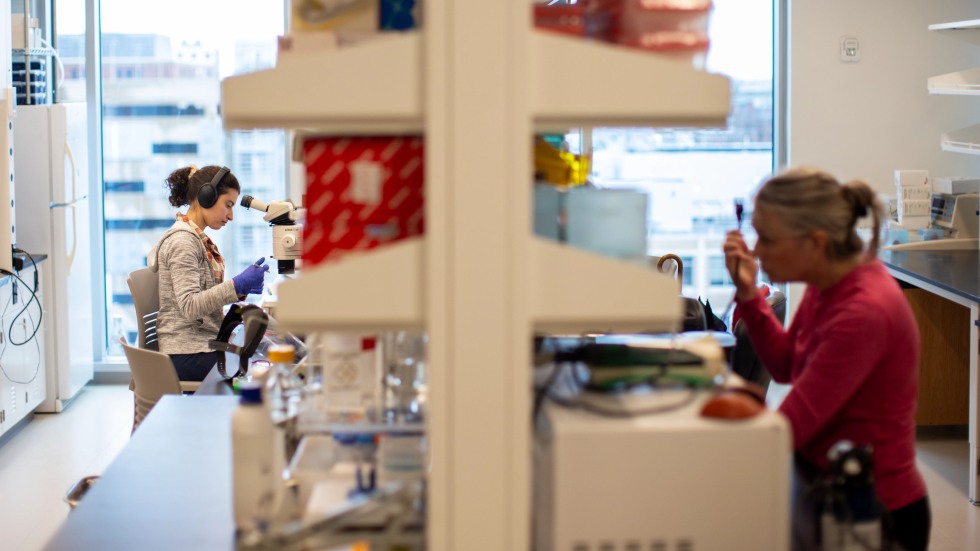PROVIDENCE, R.I. [Brown University] — The incubators and centrifuges are plugged in. Refrigerators are humming. Beakers, scales and microscopes have been unpacked. And 31,000 square feet of new Brown University life sciences lab space in the Point 225 building in Providence is ready for use.
Over the past year, Brown and Wexford Science & Technology have transformed the sixth floor of 225 Dyer St. into research space designed for individual and team discovery. The new labs are located near the University’s Warren Alpert Medical School and Laboratories for Molecular Medicine as well as the site of Brown’s planned integrated life sciences building, an ambitious work in progress that will house researchers in biology, medicine, brain science, bioengineering, public health and other life sciences disciplines.
While the ILSB is still a few years from completion, the new laboratory space at 225 Dyer St. is welcoming researchers now, said Dr. Mukesh K. Jain, senior vice president for health affairs and dean of medicine and biological sciences at Brown.
“There is an urgent need for physical space to accommodate the expansive life sciences research already taking place here at Brown,” Jain said. “While we eagerly await the completion of the integrated life sciences building, we are excited to be able to offer Brown biomedical researchers beautiful, state-of-the art lab space and accompanying support technology. Across the entire sixth floor of 225 Dyer, members of the Center on the Biology of Aging, the new Brown RNA Center and faculty from biomedical engineering will now have the space and opportunity to conduct cutting-edge research and collaborate on innovative new projects.”
The University committed to the sixth floor lease in 2022 to meet its growing demand for web lab space to support health and medical research — particularly as Brown embarked upon a plan to significantly increase investment in high-impact research that benefits communities locally and nationally.
Leasing the space also continued the University’s investments in projects focused on adding vibrancy to Providence’s Jewelry District, with a particular focus on scientific and biomedical research with the potential to create new economic activity in the city and state. In addition to Brown’s new labs on the sixth floor, Wexford has transformed the seventh floor into lab-ready space as well, with the aim of appealing to life sciences companies by reducing the time necessary to build out a tenant’s laboratories.
Point 225 was already home to Brown’s School of Professional Studies and Division of Pre-College and Undergraduate Programs, as well as to dozens of companies located in CIC Providence. The sixth floor was previously an open, unfinished space with exposed concrete, said Adam McGovern, senior director of biomedical facilities planning and operations at Brown, who oversaw the buildout of Brown’s labs. Unlike standard offices, he noted, life sciences labs need appliances like sinks, ovens and refrigerators, as well as plumbing, fume hoods and extra power. The project involved upgrading electrical and HVAC systems, including the installation of a generator that could provide backup power for research equipment.
“After those large structural improvements had been made, the project became about designing the space that works in a flexible way for the researchers,” McGovern said.
Roughly two-thirds of the floor is set up as wet labs, while a third is configured as administrative space, with conference rooms, workstations and meeting areas. Sixteen research groups will ultimately occupy the floor, each with about six to 12 researchers and staff members. Construction took nine months and was finished at the end of 2023. The research groups started to move in during February.
A collaborative space for health and medical research
Gerwald Jogl’s research group, part of Brown’s Center on the Biology of Aging, didn’t have far to travel from their prior lab at 70 Ship St. to the new space at 225 Dyer. But in the process of moving, they gained a new outlook — on both the City of Providence and on their work itself. The lab of six now occupies a space with windows facing southwest, toward the medical school.
Jogl, an associate professor in the Department of Molecular Biology, Cell Biology and Biochemistry, said he appreciates how the open layout of the space is conducive to conversation on the lab’s research.
“There’s been much more interaction within my group — we get to talk more, in passing and throughout the day, and it’s easier for colleagues to see me and therefore come talk to me,” he said.



